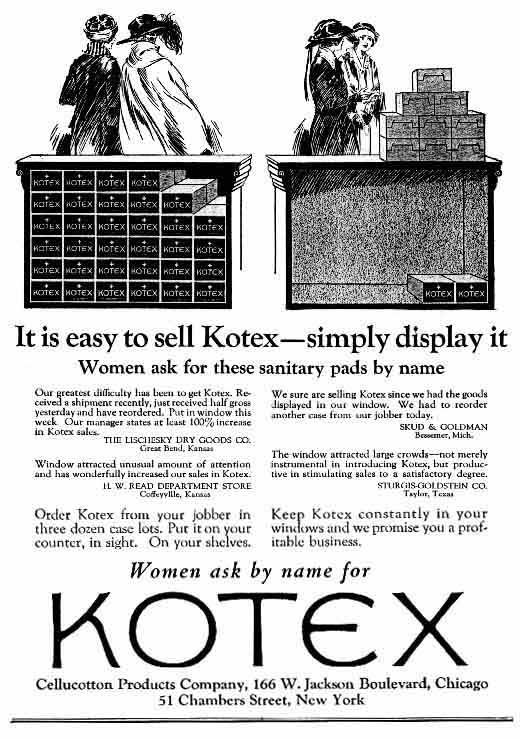See more Kotex items: First ad
(1921; scroll to bottom of page) - ad, 1928
(Sears and Roebuck
catalog) - Lee
Miller ads (first real person in a
menstrual hygiene ad, 1928) - Marjorie May's Twelfth
Birthday (booklet for girls, 1928,
Australian edition; there are many links
here to Kotex items) - Preparing for
Womanhood (1920s, booklet for girls;
Australian edition) - 1920s booklet in
Spanish showing disposal
method - box
from about 1969 - "Are you in the
know?" ads (Kotex) (1949)(1953)(1964)(booklet, 1956) -
See more ads on the Ads
for Teenagers main page


|

Advice to Merchants
about Selling
Kotex (page
for a trade
publication, 1920s, U.S.A.)
Early on,
in 1921, women were
reluctant to buy the new product
Kotex because it meant asking a
clerk for a box (even though
the company supposedly invented
the word "Kotex" so women
wouldn't have to say "sanitary
napkin"). Adman Albert Lasker,
who worked on the Kotex campaign
in the early 1920s, wrote in
Advertising Age (15 December
1952), "Just a few of us
talked to our wives and asked
them if they used Kotex, and we
found they didn't, and in almost
every case it was because they
didn't like to ask the druggist
for it."
The page
below (from the State Historical
Society of Wisconsin), made by
the Kotex producers for a trade
magazine, told stores how to
sell the embarrassing product: stack the boxes
on the counter rather than
making the lady ask for one. Apparently Albert Lasker, the "Father of
American Advertising," of the
Lord & Thomas agency, added
the idea of placing a coin box next to the
stack of boxes, completely
eliminating the need for a woman
to speak to anyone. People
seemed to be more trustworthy
then. I wonder when that
stopped?
(Isn't
that a neat hat and cape the
woman at left is wearing? Women
dressed up to go shopping at
least through the 1950s in
Washington, D.C.)
Wallace
Meyer, in a statement
dated 21 September 1960 in his
papers at the State Historical
Society of Wisconsin, disputes
Lasker's claim in an
Advertising Age article, dated
15 December 1952, to have
invented the idea of
stacking the boxes on the
counter. He writes,
In making this claim for
Lord & Thomas [Lasker's
advertising agency] someone
made a mistake[,] for the
original agency, The Charles
F. W. Nichols Company [Meyer's
company], discovered and and
promoted the wrapped package
idea before Mr. Lasker became
interested [in Kotex]. The
idea was first reported by a
copywriter, O. T. Frash, while
in Watertown, Wisconsin, on a
field trip. He saw it in
an Apothecary Shop owned by
a German-American druggist
who found that women would
buy many more packages if
they were wrapped in plain
white paper and tied with
blue string, then piled on
the counter in a pyramid
surmounted by a small neat
card reading, "Kotex - Take
a box - 65 cents."
By the way, some early Modess
ads had coupons women could cut
out and hand to clerks ("Silent
Purchase" coupons) so they
wouldn't have to ask for the pads;
apparently stores were not piling
them on the counter.
And in Germany,
stores selling Camelia,
the second German disposable pad,
invented in 1926, put a note in
each box of the pads; a woman gave
the note back to the clerk when
she needed more pads. The notes
asked the clerk for another box of
Camelia. And signs in the stores
told women to ask a female
clerk when buying Camelia.
|

From the State Historical Society of
Wisconsin
See more Kotex items: First ad
(1921; scroll to bottom of page) - ad, 1928
(Sears and Roebuck
catalog) -
Lee Miller ads
(first real person in a menstrual hygiene
ad, 1928)
© 1999 Harry Finley.
It is illegal to reproduce or distribute
work on this Web site in any manner or
medium without written permission of the
author. Please report suspected violations
to hfinley@mum.org
|